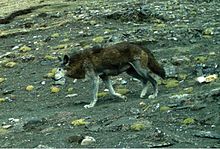喜玛拉雅狼
外观
| 喜玛拉雅狼 | |
|---|---|

| |
| 尼泊尔安纳布林纳峰保护区内的喜玛拉雅狼 | |
| 科学分类 | |
| 界: | 动物界 Animalia |
| 门: | 脊索动物门 Chordata |
| 纲: | 哺乳纲 Mammalia |
| 目: | 食肉目 Carnivora |
| 科: | 犬科 Canidae |
| 属: | 犬属 Canis |
| 种: | C. lupus
|
| 亚种: | 喜玛拉雅狼 C. l. chanco
|
| 三名法 | |
| Canis lupus chanco | |

| |
| 喜马拉雅狼分布(高地红点)与全北界灰狼(低地蓝点)的比较[2] | |
喜马拉雅狼(学名:Canis lupus chanco)[3]是一种具争议的犬属分类[2]。根据它的遗传标记,其线粒体DNA显示它的遗传基群是北极灰狼,而在遗传上则与藏狼相同[2][4][5]。喜玛拉雅狼与非洲金狼(Canis lupaster)间也有关联[2][5][6]。在喜玛拉雅狼和藏狼的狼之间并没有明显的形态差异。[7]喜马拉雅狼生活在喜马拉雅山的拉达克、青藏高原[8][9]和中亚高地。它们主要在海拔4000米以上。喜玛拉雅狼已经适应了低氧环境,而其他狼只发现在低海拔地区。[9]
特征
[编辑]
喜马拉雅狼有厚厚的皮毛,背部和尾巴呈暗褐色,面部、腹部和四肢呈黄白色。它长约110厘米(45英寸),肩高76厘米(30英寸)[10][11][12][13]。比伊朗狼大[14]。口吻、眼睛下方、上脸颊和耳朵上都有紧密排列的黑色斑点[15]。重大约35千克(77磅)[7]。
喜马拉雅狼的心脏能承受高海拔地区的低氧水平,使它的心脏跳动的基因RYR2为其原因[16]。
生活习惯
[编辑]喜马拉雅狼是群居动物,一群狼的数量大约为6至8只。一些喜马拉雅狼的栖息范围与印度狼重叠。然而,两者似乎很少发生冲突。[17]
喜玛拉雅狼通常在晚上捕猎,主要捕捉中小型动物。主要为啮齿动物和兔子,有时也会捕捉大型动物。其中包括岩羊、藏羚羊、喜马拉雅旱獭等。[18]
参考文献
[编辑]- ^ Gray, J. E. Notice of the Chanco or Golden Wolf (Canis chanco) from Chinese Tartary. Proceedings of the Zoological Society of London. 1863: 94.
- ^ 2.0 2.1 2.2 2.3 Werhahn, Geraldine; Senn, Helen; Ghazali, Muhammad; Karmacharya, Dibesh; Sherchan, Adarsh Man; Joshi, Jyoti; Kusi, Naresh; López-Bao, José Vincente; Rosen, Tanya; Kachel, Shannon; Sillero-Zubiri, Claudio. The unique genetic adaptation of the Himalayan wolf to high-altitudes and consequences for conservation. Global Ecology and Conservation. 2018-10, 16 [2022-07-21]. doi:10.1016/j.gecco.2018.e00455. (原始内容存档于2020-07-29) (英语).
- ^ Alvares, F.; Bogdanowicz, W.; Campbell, L.A.D.; Godinho, R.; Hatlauf, J.; Jhala, Y.V.; Kitchener, A. C.; Koepfli, K.-P.; Krofel, M.; Moehlman, P. D.; Senn, H.; Sillero-Zubiri, C.; Viranta, S.; Werhahn, G. Old World Canis spp. with taxonomic ambiguity: Workshop conclusions and recommendations (PDF) (报告). Vairão, Portugal: IUCN/SSC Canid Specialist Group, Centro de Investigação em Biodiversidade e Recursos Genéticos. 28th–30th May 2019 [2020-03-06]. (原始内容存档 (PDF)于2021-03-08).
- ^ Ersmark, Erik; Klütsch, Cornelya F. C.; Chan, Yvonne L.; Sinding, Mikkel-Holger S.; Fain, Steven R.; Illarionova, Natalia A.; Oskarsson, Mattias; Uhlén, Mathias; Zhang, Ya-ping; Dalén, Love; Savolainen, Peter. From the Past to the Present: Wolf Phylogeography and Demographic History Based on the Mitochondrial Control Region. Frontiers in Ecology and Evolution. 2016-12-02, 4 [2022-07-21]. ISSN 2296-701X. doi:10.3389/fevo.2016.00134. (原始内容存档于2017-03-13).
- ^ 5.0 5.1 Werhahn, Geraldine; Senn, Helen; Kaden, Jennifer; Joshi, Jyoti; Bhattarai, Susmita; Kusi, Naresh; Sillero-Zubiri, Claudio; Macdonald, David W. Phylogenetic evidence for the ancient Himalayan wolf: towards a clarification of its taxonomic status based on genetic sampling from western Nepal. Royal Society Open Science. 2017-06, 4 (6) [2022-07-21]. ISSN 2054-5703. PMC 5493914
 . PMID 28680672. doi:10.1098/rsos.170186. (原始内容存档于2022-08-03) (英语).
. PMID 28680672. doi:10.1098/rsos.170186. (原始内容存档于2022-08-03) (英语).
- ^ Koepfli, Klaus-Peter; Pollinger, John; Godinho, Raquel; Robinson, Jacqueline; Lea, Amanda; Hendricks, Sarah; Schweizer, Rena M.; Thalmann, Olaf; Silva, Pedro; Fan, Zhenxin; Yurchenko, Andrey A. Genome-wide Evidence Reveals that African and Eurasian Golden Jackals Are Distinct Species. Current Biology. 2015-08, 25 (16) [2022-07-21]. doi:10.1016/j.cub.2015.06.060. (原始内容存档于2022-08-03) (英语).
- ^ 7.0 7.1 Shrotriya, S.; Lyngdoh, S.; Habib, B. Wolves in Trans-Himalayas: 165 years of taxonomic confusion (PDF). Current Science. 2012, 103 (8) [June 27, 2014]. (原始内容存档 (PDF)于2015-09-23).
- ^ Joshi, BheemDutt; Lyngdoh, Salvador; Singh, Sujeet Kumar; Sharma, Reeta; Kumar, Vinay; Tiwari, Ved Prakash; Dar, S. A.; Maheswari, Aishwarya; Pal, Ranjana; Bashir, Tawqir; Reshamwala, Hussain Saifee. Janke, Axel , 编. Revisiting the Woolly wolf (Canis lupus chanco) phylogeny in Himalaya: Addressing taxonomy, spatial extent and distribution of an ancient lineage in Asia. PLOS ONE. 2020-04-16, 15 (4). ISSN 1932-6203. PMC 7162449
 . PMID 32298359. doi:10.1371/journal.pone.0231621 (英语).
. PMID 32298359. doi:10.1371/journal.pone.0231621 (英语).
- ^ 9.0 9.1 Werhahn, Geraldine; Liu, Yanjiang; Meng, Yao; Cheng, Chen; Lu, Zhi; Atzeni, Luciano; Deng, Zhixiong; Kun, Shi; Shao, Xinning; Lu, Qi; Joshi, Jyoti. Himalayan wolf distribution and admixture based on multiple genetic markers. Journal of Biogeography. 2020-06, 47 (6) [2022-07-21]. ISSN 0305-0270. doi:10.1111/jbi.13824. (原始内容存档于2022-07-21) (英语).
- ^ Hodgson, B. H. 7. Description of the Wild Ass (Asinus polydon) and Wolf of Tibet (Lupus laniger). Calcutta Journal of Natural History. 1847, 7: 469–477.
- ^ Blanford, W. T. Canis lupus. The Wolf. The Fauna of British India, Including Ceylon and Burma. Mammalia First. London: Taylor and Francis. 1888: 135–140.
- ^ Lydekker, R. The Tibetan Wolf. The great and small game of India, Burma, and Tibet. London: R. Ward. 1900: 339–340.
- ^ Pocock, R. I. Canis lupus chanco Gray. The Woolly Wolf. Fauna of British India. Mammals Volume 2. London: Taylor and Francis. 1941: 86–90.
- ^ Jerdon, T. C. The Indian wolf. The mammals of India: a natural history of all the animals known to inhabit continental India. London: John Wheldon. 1874: 140–141.
- ^ Chetri, Madhu; Jhala, Yadvendradev; Jnawali, Shant Raj; Subedi, Naresh; Dhakal, Maheshwar; Yumnam, Bibek. Ancient Himalayan wolf (Canis lupus chanco) lineage in Upper Mustang of the Annapurna Conservation Area, Nepal. ZooKeys. 2016-04-21, 582 [2022-07-21]. ISSN 1313-2970. PMC 4857050
 . PMID 27199590. doi:10.3897/zookeys.582.5966. (原始内容存档于2022-01-26).
. PMID 27199590. doi:10.3897/zookeys.582.5966. (原始内容存档于2022-01-26).
- ^ Zhang, Wenping; Fan, Zhenxin; Han, Eunjung; Hou, Rong; Zhang, Liang; Galaverni, Marco; Huang, Jie; Liu, Hong; Silva, Pedro; Li, Peng; Pollinger, John P. Akey, Joshua M. , 编. Hypoxia Adaptations in the Grey Wolf (Canis lupus chanco) from Qinghai-Tibet Plateau. PLoS Genetics. 2014-07-31, 10 (7). ISSN 1553-7404. PMC 4117439
 . PMID 25078401. doi:10.1371/journal.pgen.1004466 (英语).
. PMID 25078401. doi:10.1371/journal.pgen.1004466 (英语).
- ^ Himalayan Wolf. Wolf Facts. [2022-01-09]. (原始内容存档于2021-01-23).
- ^ Himalayan Wolf (Canis himalayensis). The Wolf Intelligencer. [2022-01-09]. (原始内容存档于2022-01-11).
